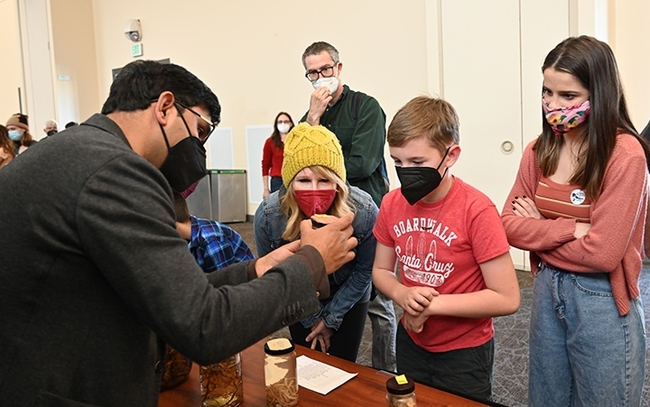- Author: Kathy Keatley Garvey
(Note: The main UC Davis Department of Entomology news page is at https://entomology.ucdavis.edu.)
What's a picnic without bugs!
The UC Davis Department of Entomology and Nematology is gearing up for the 110th annual UC Davis Picnic Day, set April 20.
This year, all of the entomology exhibits, including those at the Bohart Museum of Entomology, will be at Briggs Hall. (The Bohart Museum headquarters in the Academic Surge Building will be closed on Picnic Day.)
Picnic Day at Briggs Hall is from 9 a.m. to 5 p.m. Some of the activities will closer earlier.
The list of events and activities in and around Briggs Hall will include:
Bug Doctor
Briggs Hall Entryway
Graduate students will answer questions about insects. What's that bug? Attendees are encouraged to bring an insect or photo for identification.
Cockroach Races
Front of Briggs Hall
American cockroaches, Periplaneta americana, from Bob Kimsey's forensic lab, race on a specially made track, while roach fans cheer for their favorites. (Sometimes the athletes are named for faculty, friends or bystanders.)
Medical Entomology
122 Briggs Hall
Carla-Cristina "CC" Melo Edwards of the Geoffrey Attardo lab is coordinating the medical entomology display. Her research focuses on investigating the physiological mechanisms underlying pyrethroid resistance in Aedes aegypti (the yellow fever mosquito).
Diversity of Arachnids
122 Briggs Hall
Doctoral student Emma Jochim of the Jason Bond lab is coordinating an exhibit she created last year to display the diversity of arachnids, such as vinegaroons, whip spiders, tarantulas, and scorpions. "We'll have live animals and fact sheets that will give a general overview of their diversity, behavior, and habitat," Jochim said. "I'll also bring some curated specimens to show what goes into creating a scientific collection and talk about why collections are important for understanding biodiversity. "
Maggot Art
Briggs Courtyard
Artists--children and adults alike--create maggot art by dipping a live maggot into water-based, non-toxic paint. It's suitable for framing (or at least a spot on the refrigerator door). This event will close at 3 p.m. this year (last year it was at 5 p.m.)
Dr. Death
122 Briggs Hall
Forensic entomologist Robert Kimsey will display and discuss his work in his "Dr. Death" booth. Last year Kimsey pin-mounted and identified flies from various cases and research efforts, and displayed studies on the sequence of development of individual maggots, calling attention to the development and sequence of communities of insect maggots. "By these means, approximations about how long a person has been dead can be made," he told the crowd.
Entomology at UC Davis
122 Briggs Hall
Displays of insects, including bees, ants and more. Graduate students, faculty and emeriti will staff the tables.
Bohart Museum of Entomology
Front of Briggs Hall
A pop-up tent, staffed by the Bohart Museum, will include stick insects (walking sticks) and Madagascar hissing cockroaches. "We are excited to be part of the bigger department's offerings," said Tabatha Yang, education and outreach coordinator. Give-aways are also planned.
Fly-Tying
Briggs Hall courtyard
Fly Fishers of Davis will show attendees how to tie a fly. The recipients take home the flies.
Insect-Themed T-Shirt Sales
Briggs Hall entryway
Members of the Entomology Graduate Student Association (EGSA), led by president Mia Lippey, will be selling their popular insect-themed t-shirts, including The Beetles. The T-shirt, EGSA's all-time best seller, is a take-off of the cover of The Beetles' Abbey Road alum. However, instead of the Beatles crossing the road in a single file, four beetles (family names Phengogidae, Curculionidae, Cerambycidae and Scarabaeidae) do so.
Mosquito Control Booth
Entrance to Briggs (below front steps)
Sacramento-Yolo Mosquito and Vector Control District will be providing information on mosquitoes, answering questions, and handing out give-a-ways, including mosquito repellent.
UC Statewide Integrated Pest Management (UC IPM)
Briggs Hall Courtyard
“We plan to have many of our usual materials on display and will be giving out the live lady beetles (aka ladybugs) again,” said urban and community IPM educator Lauren Fordyce. “We purchase them from a local garden center. In addition to that, we plan to have a prize wheel that adults and kids can spin, answer a question, and win a prize if they answer correctly. We may also have temporary insect tattoos to give away.”
Ranked Third in the Country. The UC Davis Department of Entomology and Nematology is ranked third among “The Best Entomology Colleges in the United States for 2024" by universities.com. The department includes 24 active and 19 retired faculty; 28 graduate students (five in the master's degree program and 23 in the doctoral degree program); 47 undergraduate entomology majors (based on the Office of Academic Support and Instructional Services (OASIS) Student Reports); and a staff comprised of 27 academics (non-faculty), 24 career, and 56 student assistants. Professor and chair of the department is molecular geneticist and physiologist Joanna Chiu.
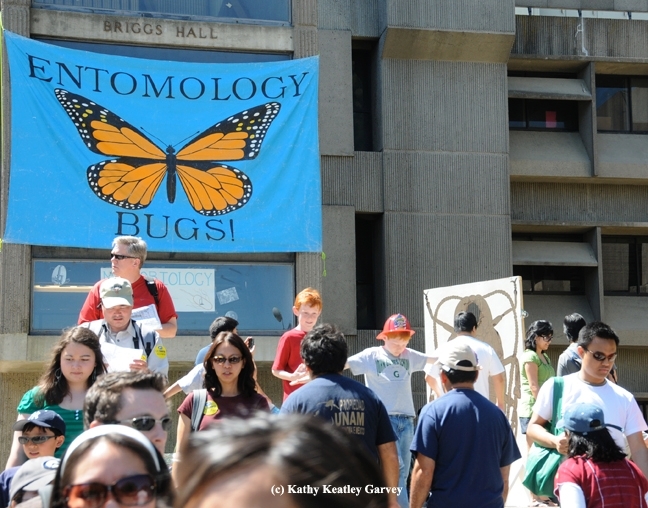
- Author: Kathy Keatley Garvey
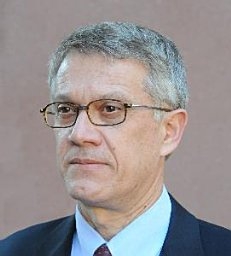
The research, “Circabidian Rhythm of Sex Pheromone Reception in a Scarab Beetle,” published in the Jan. 18 edition of Current Biology, marks the first sex pheromone receptor identified in Coleoptera, the order of beetles.
While most insects exhibit a 24-hour circadian rhythm that regulates their behavior and physiology, the large black chafer beetle, Holotrichia parallela, operates on a 48-hour clock, said Leal, a global expert on insect olfaction and communication. A professor in the Department of Molecular and Cellular Biology, he is a former professor and chair of the UC Davis Department of Entomology, now the Department of Entomology and Nematology.
“Insects smell with their antennae,” said Leal, who has unraveled the molecular mechanisms of mosquitoes, true bugs, long horned beetles, moths and other insects. “They have a sophisticated olfactory system and can selectively detect minute amounts of odorants.”
The female H. parallela emerges from the soil every other night, after sunset, climbs the canopy of the host plant, and seeks a mate by releasing a sex pheromone. Leal wanted to know if the males are also on a 48-hour rhythm clock, and he wanted to identify the elusive male gene in the pheromone receptor that allows the male to scent the female's pheromone.
The answers: “yes” and “yes.”
“I have been waiting for almost three decades to answer these questions,” Leal said. “I identified the sex pheromone of this beetle species in 1993 while working for the Ministry of Agriculture and Forestry of Japan. At that time, I found for the first time a very unusual sex pheromone, which is derived from an amino acid. Now similar sex pheromones have been identified from many species of beetles.”
“Also, we showed that females produce the sex pheromone every other night,” Leal said. “The burning question in biology is what males do about sensing or smelling the female sex pheromone. Back then, we had no idea how insects sense smell. With the advancements in sequencing, we identified all potential receptors and identified which one senses the sex pheromone. COVID happened and delayed our research collaboration. Finally, we found that the receptor is expressed every other day.”
“This is remarkable,” Leal said. “How do they know when it is a 'date night' or a non-calling night? It is still a mystery, but we will find out one day.”
Leal and Yin and their team pointed out that virtually all life on Earth experiences a 24-hour circadian rhythm, which affects almost all behaviors, including sexual activity and mating.

Leal, a native of Brazil, received his Ph.D. in applied biochemistry from the University of Tsukuba, Japan, with subsequent postdoctoral training in entomology and chemical ecology at the National Institute of Sericultural and Entomological Science and Cornell University, respectively. He was the first non-Japanese person to earn tenure at Japan's Ministry of Agriculture, Forestry, and Fisheries.
Leal, who joined the UC Davis faculty in 2000, is a newly elected trustee of the Royal Entomological Society, the first UC Davis scientist to be elected a trustee. He chaired the UC Davis Department of Entomology in 2006-2008 before accepting a position in 2008 as professor of biochemistry in the Department of Molecular and Cellular Biology. His many honors include Fellow of the Entomological Society of America (2009), American Association for the Advancement of Science (2005), and the National Academy of Inventors (2019).
Other co-authors of the Current Biology paper: Yinliang Wang, Huanhuan Dong, Yafei Qu, Jianhui Qin, Kebin Li, Yazhong Cao and Shuai Zhang, Chinese Academy of Agricultural Sciences, Beijing; Yuxin Zhou and Bingzhong Ren, Northeast Normal University, Changchun, China; and Chen Luo, Beijing Academy of Agriculture and Forestry Sciences.
The research drew financial support from the National Key R&D Foundation of China; National Natural Science Foundation, China; and the Natural Science Foundation of Beijing.
Resources:
- For This Beetle, ‘Date Night' Comes Every Other Day, Jan. 18, 2024, Andy Fell, UC Davis News and Media Relations
- Walter Leal Elected Trustee of Royal Entomological Society, Sept. 5, 2023
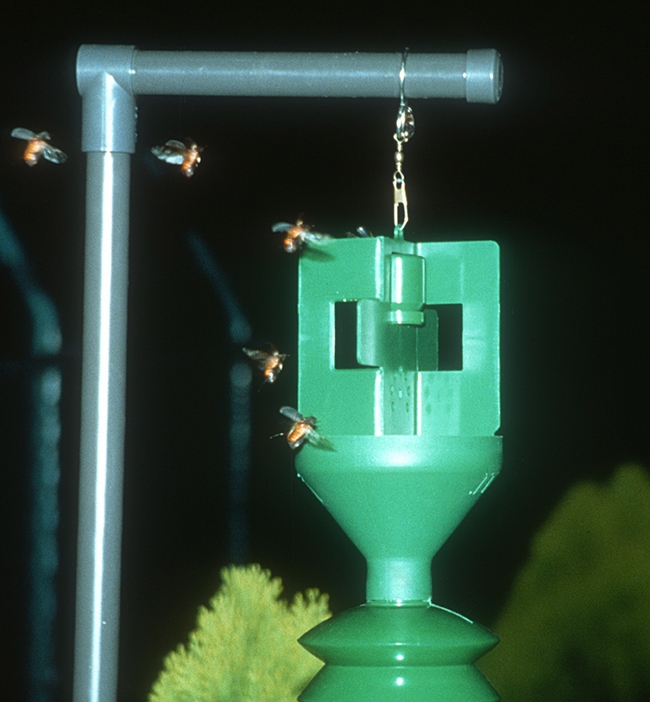

- Author: Kathy Keatley Garvey
The Bohart Museum of Entomology recently hosted an evening open house to engage and inform UC Davis Department of Entomology and Nematology biologists on how to streamline their efforts at all stages of their research, from collecting insects and arachnids to using the Bohart specimens.
More than two dozen scientists, including UC Davis undergraduates, graduate students, postdoctoral scholars, researchers, associates and faculty, attended. They gathered information on:
- Making wet, dry or cryo collections
- Donating, borrowing or sampling museum specimens from the Bohart or from collections around the world
- Prepare specimens and formatting labels
- Field collecting (equipment, permits, storing, regionally and internationally)
- Identifications services
- Language for grants, and budget development
- Science communication: public outreach, and broader impacts
UC Davis distinguished professor Lynn Kimsey, director of the Bohart Museum, led the event. Entomologist Jeff Smith, who curates the lepidoptera collection, offered a pinning demonstration. (See one of his previous videos.) Others assisting were other Bohart staff and associates, including the laboratory of arachnologist Jason Bond, the Evert and Marion Schlinger Endowed Chair, UC Davis Department of Entomology and Nematology, and associate dean, UC Davis College of Agricultural and Environmental Sciences.
The Bohart Museum has an online playlist of 11 short videos on "How to Make an Insect Collection." It was the brainchild of UC Davis distinguished professor James R. Carey, who led a class of entomology students 13 years ago to create tightly scripted clips, with an emphasis on brevity, simplicity and low cost.
The entire series can be viewed in less than 10 minutes. The clips range in length from 32 seconds to 77 seconds. UC Davis forensic entomologist Robert Kimsey provided the introductory narration for each clip. See Bohart web page for more information on insect collecting and links to the videos.
- Hand Collecting
- Using an Aspirator
- Ground Collecting
- Aquatic Collecting
- Using Nets
- How to Kill Insects
- Pinning
- How to Point Mount
- Labeling
- Spreading
- Storage and Display
The Bohart Museum, founded in 1946, houses a global collection of eight million insect specimens. The insect museum is open to the public Mondays through Thursdays, from 8 a.m. to noon, and from 1 to 5 p.m. For more information contact bmuseum@ucdavis.edu or telephone (530) 752-0493.
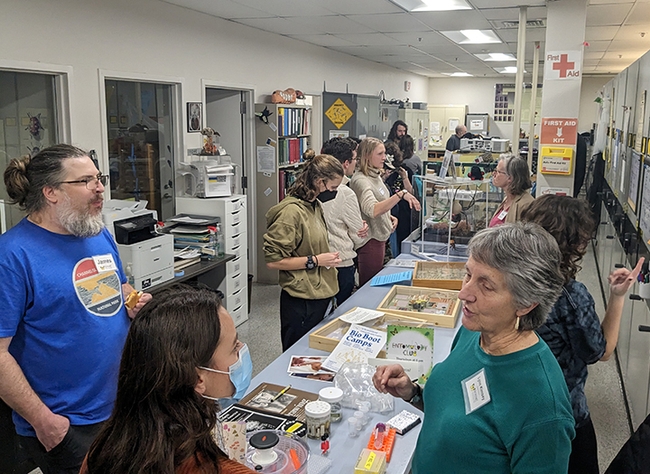
- Author: Kathy Keatley Garvey
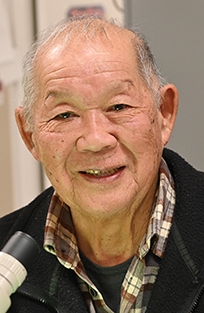
Kaya, who joined the UC Davis faculty in 1976 and retired in 2010, has known Lynn and her husband, Robert "Bob," for more than four decades. Both the Kimseys received their bachelor and doctoral degrees in entomology from UC Davis.
"I never had Lynn in a classroom situation, but she was always helpful in helping others ID insects," Kaya said. He and Lynn worked on a McKnight Foundation potato grant project in Peru for four years. He remembers Bob as a "super student in my insect pathology class."
Lynn, then Lynn Siri, received her bachelor's degree in 1975 and her doctorate in 1979, while Bob received his bachelor's degree in 1977 and his doctorate in 1984. Lynn joined the UC Davis faculty in 1989 and has directed the Bohart Museum since 1990. Bob, a forensic entomologist, joined the UC Davis faculty in 1984 as a lecturer. Both plan to retire this year.
Harry Kaya is internationally recognized for his contributions to insect pathology and insect nematology, which include more than 250 peer-reviewed publications. He co-authored an insect pathology book in 1993; co-edited another insect pathology book in 2012; and co-edited five books in several disciplines including forest entomology, entomopathogenic nematology, and invertebrate pathology.
He was named a fellow of the Entomological Society of America (ESA) in 2007.
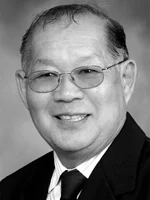
At the seminar, co-organizer Lynn Lebeck, then executive director of the Association of Natural Biocontrol Producers, praised him as a top-notch researcher and as "a warm human being." She recalled the "many years of fun times and great research experiences with him." (See news story)
Kaya co-founded the journal Biological Control, and served as the co-editor of the first and second editions of Field Manual of Techniques in Invertebrate Pathology, Application and Evaluation of Pathogens for Control of Insects and other Invertebrate Pests.
Born and raised in Honolulu, Harry received his bachelor's degree in entomology in 1962 from the College of Tropical Agriculture, University of Hawaii (UH). He served in the U.S. Army, and after being discharged as a first lieutenant, earned his master's degree in entomology from UH in 1964, specializing in insect ecology. In 1970, UC Berkeley awarded him his doctoral degree in entomology. with research in insect pathology.
From 1971 to 1976, Kaya worked as an entomologist at the Connecticut Agricultural Experiment Station in New Haven and conducted research on biological control of forest insects. In 1976, he joined the UC Davis faculty as an assistant professor, attaining the rank of full professor in 1984. He became a distinguished professor of entomology in 2008.
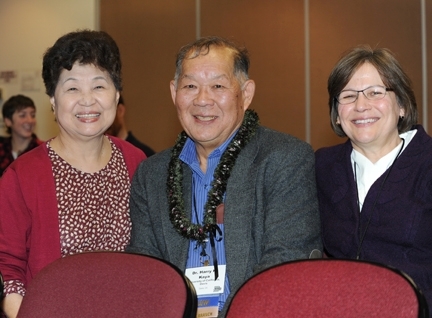
Kaya chaired the Department of Nematology from 1994 to 2001. He also served as an officer in the Society of Invertebrate Pathology (treasurer, 1990–1994, vice-president, 2000–2002, and president-elect 2002–2004), and was one of the founding editors of the journal Biological Control.
Highly honored by his peers, Kaya received the 1998 C. W. Woodworth Award, the highest honor presented by the Pacific Branch, ESA. In 2000, he received the 2000 Recognition Award in Entomology from ESA and Fellow of the Society of Nematologists. The Society for Invertebrate Pathology and UH also presented him with several awards.
In honoring him as a Fellow, ESA posted this on its website: "Kaya has mentored many graduate students and post-doctoral researchers who have proceeded to establish their own careers and excel in research and teaching. His laboratory hosted and trained many visiting scientists from other countries who have become leaders in research with entomopathogenic nematodes upon their return to their own countries. These include scientists from Korea, Thailand, Turkey, Mexico, Ukraine, and Peru. Kaya maintains a strong relationship with many of them and he had research projects with scientists from Korea and Turkey."
Kaya's first four PhD students--Raquel Alatorre, Arnold Hara, Phyllis Hotchkin {Weintraub) and Robin Goblin-Davis--are all retired from their faculty and research positions. Arnold Hara died Nov. 18, 2022.
Kaya resides in Davis with his wife, Joanna. He enjoys spending time with his grandchildren and gardening, and used to fish with colleague Les Ehler (1946-2016). "No fishing since Les passed away," he related.
One of his granddaughters, Madelyn Lee, a freshman at UC Riverside, may follow in his footsteps. "She has always been interested in the biological sciences and has become an active member of the Entomology Club at Riverside. She is thinking about being an entomology major."
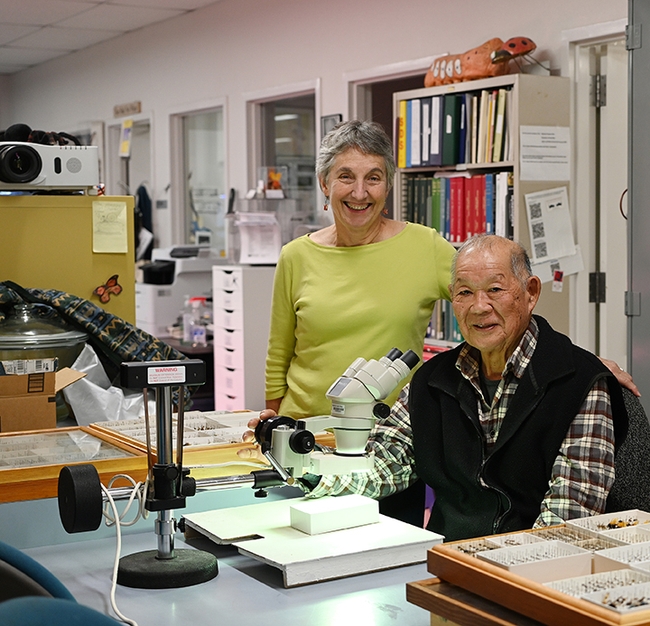
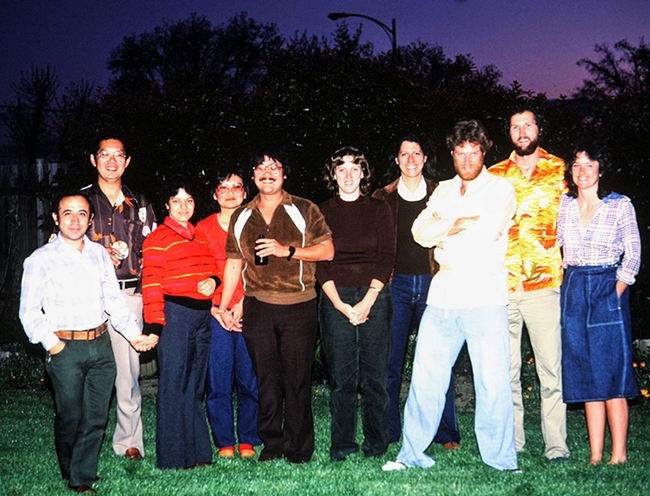
- Author: Kathy Keatley Garvey
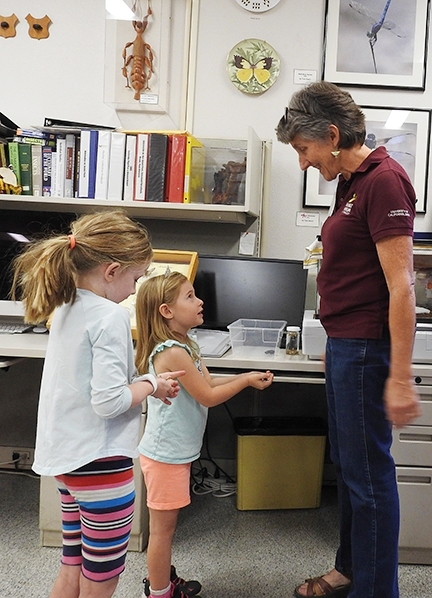
The event, set for Saturday, Feb. 10, will feature 10 museums or collections:
- Anthropology Museum, 328 Young Hall and grounds, open from noon to 4 p.m.
- Arboretum and Public Garden, Habitat Gardens in the Environmental GATEway, adjacent to the Arboretum Teaching Nursery on Garrod Drive, 10 a.m. to 2 p.m.
- Bohart Museum of Entomology, Room 1124 and main hall of the Academic Surge Building, 455 Crocker Lane, 10 a.m. to 2 p.m.
- Botanical Conservatory, the greenhouses along Kleiber Hall Drive, 10 a.m. to 2 p.m.
- California Raptor Center, 1340 Equine Lane, off Old Davis Road, 9 a.m. to 3 p.m.
- Center for Plant Diversity, Katherine Esau Science Hall off Kleiber Hall Drive, 10 a.m. to 2 p.m.
- Nematode Collection, Katherine Esau Science Hall, off Kleiber Hall Drive, 10 am. to 2 p.m..
- Museum of Wildlife and Fish Biology, Room 1394, Academic Surge Building, 455 Crocker Lane, 10 a.m. to 2 p.m.
- Paleontology Collection, Department of Earth and Planetary Sciences, 1309 Earth and Physical Sciences Building, 434 LaRue Road, 10 a.m. to 2 p.m.
- Phaff Yeast Culture Collection, Robert Mondavi Institute Brewery and Food Processing facility, Old Davis Road, 10 a.m. to 2 p.m.
Each year more than 200 volunteers--students, staff and faculty--from across campus help more 4,000 visitors--including other UC Davis students, staff and faculty--"learn about biodiversity through our amazing biological collections," said UC Davis Biodiversity Museum Day chair Tabatha Yang, education and outreach coordinator for the Bohart Museum of Entomology.
The Bohart Museum founded UC Davis Biodiversity Museum Day.
